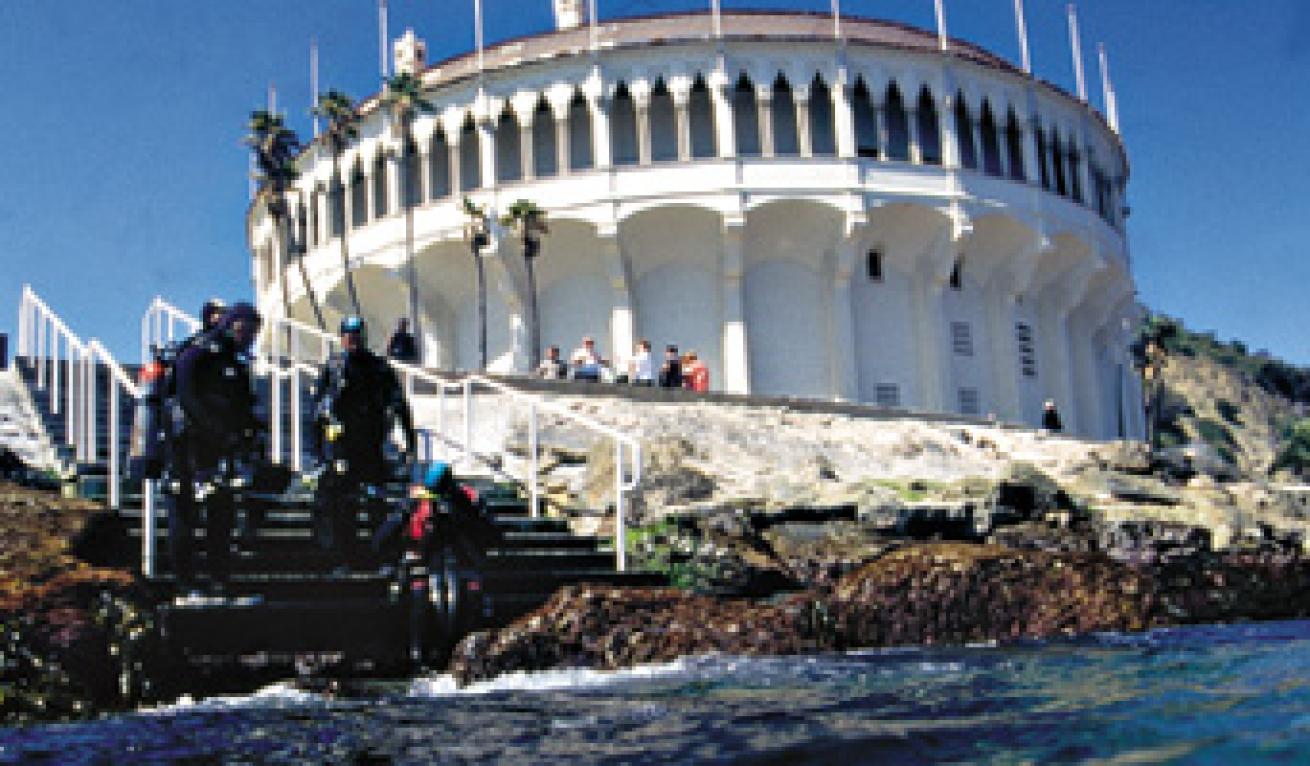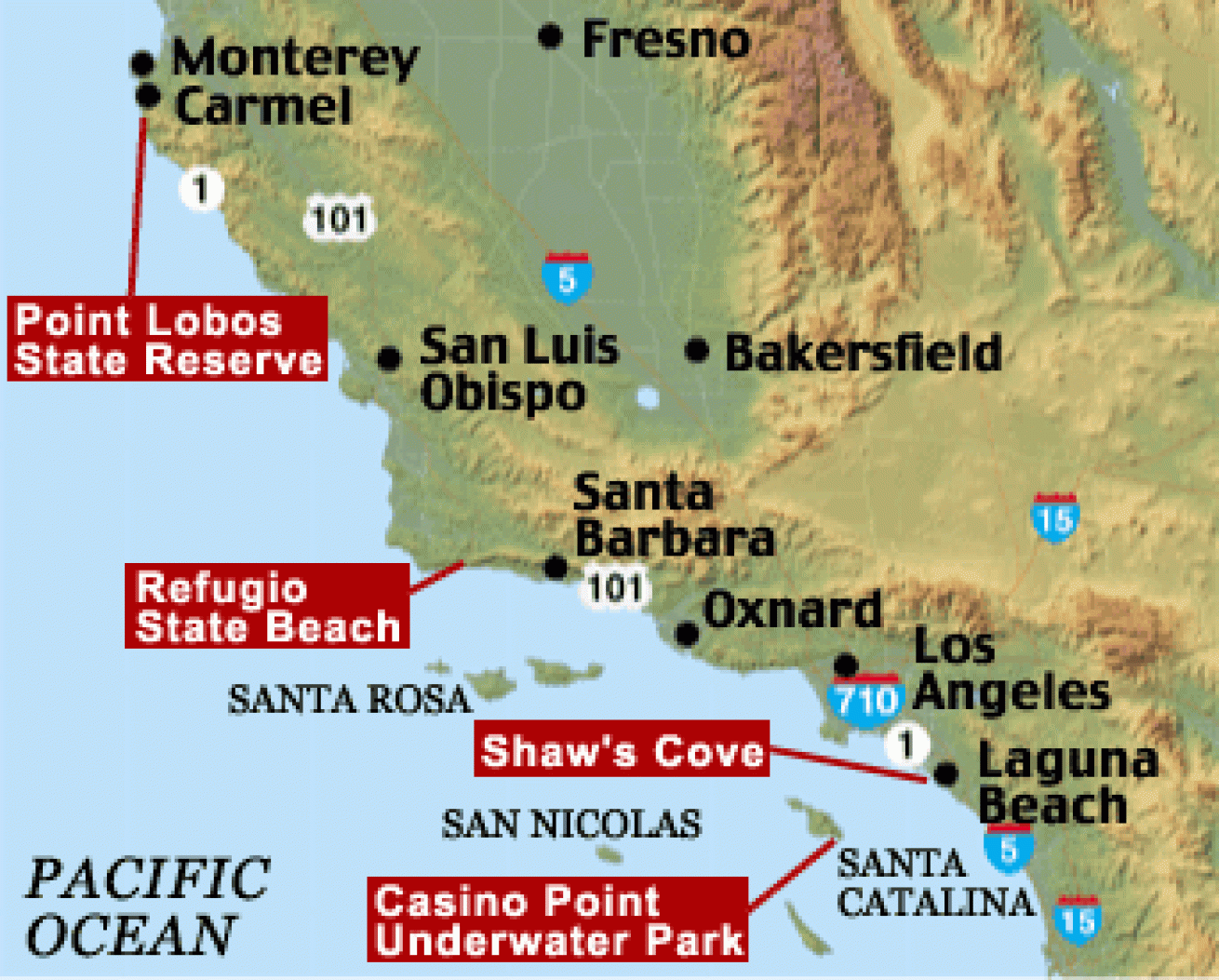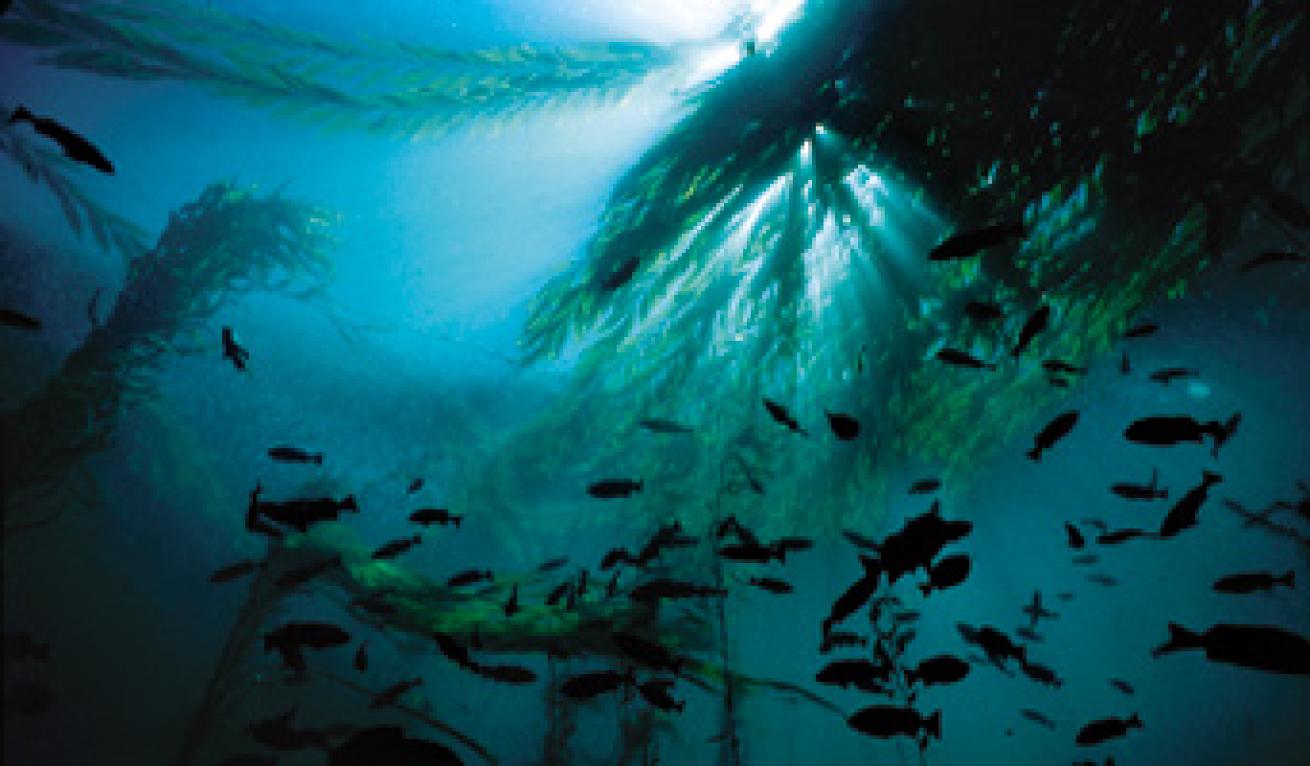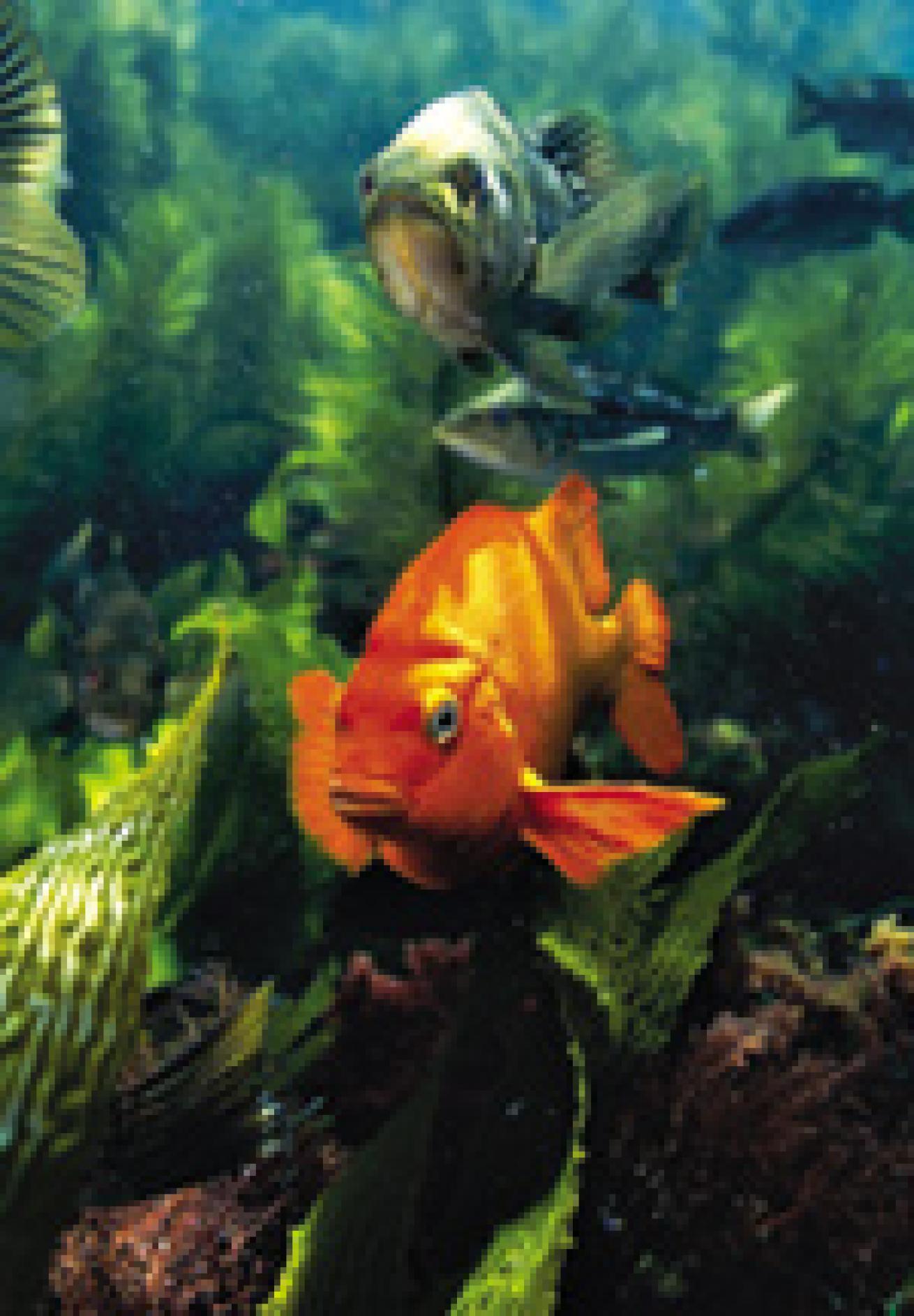Southern California Dream Dives
 |
| The shore entry at Casino Point. |
March 2004
By John Francis
Photography by BradleyIreland.com
Some people beyond the Sierras picture Southern California as the land of laid-back, mellow slackers in beach shacks. They imagine a beach dive here means making a short, easy drive to an idyllic beach, sidestepping bikini-clad babes after suiting up, and taking only a few steps to the water.
More often, a So Cal beach dive means being stuck in traffic, searching, searching, searching for a parking space and gearing up on the asphalt shoulder of the Pacific Coast Highway. Luckily, however, there are dive sites that recall the slower, more spacious California of 50 years ago.
Refugio State Beach
Refugio is one of them. Take the Ventura Freeway west from L.A., out of the Valley. Suburbia drops behind when you crest the Conejo Grade and the Pacific gleams in the distance. Old Highway 101 rolls along the grassy benchland, brown hills to your right, the sea cliff to the left. Your shoulder muscles relax and you breathe deeper.
About 20 miles past Santa Barbara, a road sign marks the turnoff for Refugio State Beach, which has more than 100 campsites under palm trees, day-use parking, rest rooms, an easy beach entry and a chain of sweet reefs just offshore.The Spanish word refugio means refuge or shelter, and that's just what you'll find here. Past the flat, sandy bottom just off the beach are shallow kelp beds, where opaleye and calico bass hang out. Beyond the kelp, a series of ledges to the left have overhangs that once sheltered abalone. You might find scallop or maybe even lobster holed up.
Besides anemones and nudibranchs, there's a thriving collection of starfish among the rocks, including big bat stars, sun stars, blood stars and varieties you've never seen before. This is a transition zone between southern and central California, and what you see on a dive varies, depending on conditions. Don't dive with a goal of seeing something at Refugio; just cruise and see what it brings.
You can easily launch an inflatable or a kayak from Refugio because the beach is flat and close to asphalt. Take a tank and explore to the west toward Tajiguas or to the east toward El Capitan for more reefs, more kelp and more solitude. L.A. can wait.
 |
Casino Point Underwater Park
You've got every terrain here, from sand to rock pile to walls and ledges. You've got depths from snorkeler shallow to tech deep. You've got wrecks and kelp and lots of animal life from big sea bass and harbor seals to stars and anemones with lots of senoritas and garibaldi, sheepshead and calicos, moray eels and lobster in between. All of them are unusually approachable because they've been protected for many years. Add the clearest and warmest water in the state, convenient air fills, pavement (not sand) to gear up on and a wall to sit on while you do it, an easy entry (stairs!), no long surface swim and you've got an easy dive in aquarium-like conditions.
If a dive can be too good and too easy, Catalina Island's Casino Point Underwater Park is it. Divers, who vote with their fins, have made it California's most popular shore dive.There's a big parking structure at the foot of the Long Beach Freeway, which, admittedly, is still 25 miles short of your destination, but don't worry. Take the Golden Shore exit, turn right at the stop sign and follow the road to the Catalina Express Landing. Park in the structure to the left. From here, you can board a ferry. Ferry departures start at 6:15 a.m. and return as late as 9 p.m., depending on the day and season. You can wheel all your dive gear on board over ramps, and because the ferry owners are used to catering to divers, a storage area is set aside for scuba gear. An hour later, the boat docks in Avalon. The Underwater Park is a 20-minute walk to the other side of the bay, but you can rent a pushcart at Catalina Divers Supply on the green pier. (You can also rent tanks and weights.)
At the end of the sidewalk just past the Casino is a large paved area. The air fill truck is here and so are the stairs into the water.
Keep an eye out for garibaldis, Catalina's signature species. The bright orange fish are often found nesting here. The male garibaldi spreads a patch of red algae, which he hopes will attract a female to lay her eggs. Once she does, the male is fiercely protective of the eggs. He'll clean the patch of debris and attack anything--and anyone--who comes near. In springtime, don't miss the wreck of the glass-bottom boat. The boat is in 60 feet of water, about 30 feet to the left of the red buoys.
 |
| Kelp forests are just a short swim from shore at Refugio. |
Point Lobos State Reserve
One way to avoid crowded dive sites is to keep the crowd away from the dive site. There isn't a nightclub as exclusive as the Point Lobos State Reserve, four miles south of Carmel on Highway 1. You have to be on the guest list to dive here, and for a weekend dive, you'd better sign up two months in advance. Only 15 permits, one for each buddy team of two divers, are issued daily. And there are club rules. You must have a buddy and a BC, you must enter at the boat ramp in Whalers Cove, you may dive only in Whalers Cove and Bluefish Cove, and you may not touch, tease, chase or bother anything. Possession of banned substances--meaning hunting gear--is strictly prohibited.
But this is one club worth the hassle of admission. Inside, it's truly wild. Powerful, cold ocean currents funnel plankton through the canyons, crevices and caverns of the reserve, generating an explosion of life. Hydrocorals, stars and anemones in dozens of species and twice as many colors cover every rocky surface. Clouds of blacksmith and bluefish sheltering under the kelp are so approachable they seem tame. Large-animal encounters with seals, sea lions, leopard sharks and lingcod are common.
Several "rooms" open out from the entry at the boat ramp. To the right is Coal Chute Cove with several caverns. One, at 25 feet deep on the south shore of the cove, is a tunnel through the the point back to Whalers Cove. Though the entrance is comfortably wide, the tunnel narrows considerably before it ends in Whalers Cove. That will accelerate any surge, making a transit dangerous in anything but a flat calm. But it's a remarkable journey. Filter-feeding sponges are abundant along the ceiling and upper walls, and the walls and boulders are painted in their richly colored hues.
Shaw's Cove, Laguna Beach
Nowhere is the land/sea contrast more striking than at Shaw's Cove in Laguna Beach. In summer, the town is jammed with tourists. But Shaw's Cove and a mystery world called The Labyrinth is far removed from the town's conspicuous consumption. Turn off the Pacific Coast Highway at Fairview and drive one block toward the ocean to Cliff Drive. Gear up and trudge down the stairs to the beach and wade in. Follow the west wall of the cove past the surf line until the bottom depth reaches about 30 feet. A canyon is to your right with an arch over it.
Swim under and into an area of crevasses, canyons, chutes and tunnels, jeweled like Aladdin's Cave with anemones, nudibranchs, urchins and stars. The canyon walls lean in above you, and in the gloom cracks and crevasses appear on both sides. After passing over a large rock in the floor, the canyon becomes tighter, the overhanging walls almost touching above you. Now you're in a cave, or rather a tunnel, as the end of the canyon opens into Crescent Bay, the next cove to the west. If the ocean is still, you can actually pass through, but any swell is magnified in the narrow reaches of the canyon and the many rocks on the floor make this dangerous.
||
|---|
|

|
Refugio State Beach > From Santa Barbara, travel north on U.S. 101 about 25 miles to Refugio State Beach turnoff. Cross under the railroad tracks and turn right. Camping is $16 per night and day-use parking is $6. For camping reservations (recommended), call (800) 444-7275.
Casino Point Underwater Park > From Los Angeles, travel south on Interstate 710 (Long Beach Freeway) to Golden Shore, right at stop sign to Catalina Express Terminal. Park in structure to the left ($9). Round-trip fare to Avalon is about $43, but rates and schedules vary with the season. Departures are also possible from San Pedro and Dana Point. Call Catalina Express at (310) 519-1212. At Avalon, gear rentals, cart rentals and air fills are available from Catalina Divers Supply on the green pier. Call (310) 510-0330. Tank rental is $10, weights, $15, and air fill at the pier or Casino, $5. There is no charge for diving the underwater park.
Point Lobos State Reserve > From Carmel, travel four miles south on Highway 1. Dive reservation is $7 per buddy team of two; parking is $5. Call (631) 624-8413 for conditions report and reservations, or go to www.ptlobos.org.
Shaw's Cove > Take Highway 1 to Fairview Street in Laguna Beach. Turn north (toward the ocean) to Cliff Drive where Fairview dead-ends, and park wherever you can (you'll be ticketed if you park in a no-parking zone). The path to the stairs to the public beach is at the end of Fairview. There is no charge to dive here.

| The shore entry at Casino Point.|
March 2004
By John Francis
Photography by BradleyIreland.com
Some people beyond the Sierras picture Southern California as the land of laid-back, mellow slackers in beach shacks. They imagine a beach dive here means making a short, easy drive to an idyllic beach, sidestepping bikini-clad babes after suiting up, and taking only a few steps to the water.
More often, a So Cal beach dive means being stuck in traffic, searching, searching, searching for a parking space and gearing up on the asphalt shoulder of the Pacific Coast Highway. Luckily, however, there are dive sites that recall the slower, more spacious California of 50 years ago.
Refugio State Beach
Refugio is one of them. Take the Ventura Freeway west from L.A., out of the Valley. Suburbia drops behind when you crest the Conejo Grade and the Pacific gleams in the distance. Old Highway 101 rolls along the grassy benchland, brown hills to your right, the sea cliff to the left. Your shoulder muscles relax and you breathe deeper.
About 20 miles past Santa Barbara, a road sign marks the turnoff for Refugio State Beach, which has more than 100 campsites under palm trees, day-use parking, rest rooms, an easy beach entry and a chain of sweet reefs just offshore.The Spanish word refugio means refuge or shelter, and that's just what you'll find here. Past the flat, sandy bottom just off the beach are shallow kelp beds, where opaleye and calico bass hang out. Beyond the kelp, a series of ledges to the left have overhangs that once sheltered abalone. You might find scallop or maybe even lobster holed up.
Besides anemones and nudibranchs, there's a thriving collection of starfish among the rocks, including big bat stars, sun stars, blood stars and varieties you've never seen before. This is a transition zone between southern and central California, and what you see on a dive varies, depending on conditions. Don't dive with a goal of seeing something at Refugio; just cruise and see what it brings.
You can easily launch an inflatable or a kayak from Refugio because the beach is flat and close to asphalt. Take a tank and explore to the west toward Tajiguas or to the east toward El Capitan for more reefs, more kelp and more solitude. L.A. can wait.

Casino Point Underwater Park
You've got every terrain here, from sand to rock pile to walls and ledges. You've got depths from snorkeler shallow to tech deep. You've got wrecks and kelp and lots of animal life from big sea bass and harbor seals to stars and anemones with lots of senoritas and garibaldi, sheepshead and calicos, moray eels and lobster in between. All of them are unusually approachable because they've been protected for many years. Add the clearest and warmest water in the state, convenient air fills, pavement (not sand) to gear up on and a wall to sit on while you do it, an easy entry (stairs!), no long surface swim and you've got an easy dive in aquarium-like conditions.
If a dive can be too good and too easy, Catalina Island's Casino Point Underwater Park is it. Divers, who vote with their fins, have made it California's most popular shore dive.There's a big parking structure at the foot of the Long Beach Freeway, which, admittedly, is still 25 miles short of your destination, but don't worry. Take the Golden Shore exit, turn right at the stop sign and follow the road to the Catalina Express Landing. Park in the structure to the left. From here, you can board a ferry. Ferry departures start at 6:15 a.m. and return as late as 9 p.m., depending on the day and season. You can wheel all your dive gear on board over ramps, and because the ferry owners are used to catering to divers, a storage area is set aside for scuba gear. An hour later, the boat docks in Avalon. The Underwater Park is a 20-minute walk to the other side of the bay, but you can rent a pushcart at Catalina Divers Supply on the green pier. (You can also rent tanks and weights.)
At the end of the sidewalk just past the Casino is a large paved area. The air fill truck is here and so are the stairs into the water.
Keep an eye out for garibaldis, Catalina's signature species. The bright orange fish are often found nesting here. The male garibaldi spreads a patch of red algae, which he hopes will attract a female to lay her eggs. Once she does, the male is fiercely protective of the eggs. He'll clean the patch of debris and attack anything--and anyone--who comes near. In springtime, don't miss the wreck of the glass-bottom boat. The boat is in 60 feet of water, about 30 feet to the left of the red buoys.

| Kelp forests are just a short swim from shore at Refugio.|
Point Lobos State Reserve
One way to avoid crowded dive sites is to keep the crowd away from the dive site. There isn't a nightclub as exclusive as the Point Lobos State Reserve, four miles south of Carmel on Highway 1. You have to be on the guest list to dive here, and for a weekend dive, you'd better sign up two months in advance. Only 15 permits, one for each buddy team of two divers, are issued daily. And there are club rules. You must have a buddy and a BC, you must enter at the boat ramp in Whalers Cove, you may dive only in Whalers Cove and Bluefish Cove, and you may not touch, tease, chase or bother anything. Possession of banned substances--meaning hunting gear--is strictly prohibited.
But this is one club worth the hassle of admission. Inside, it's truly wild. Powerful, cold ocean currents funnel plankton through the canyons, crevices and caverns of the reserve, generating an explosion of life. Hydrocorals, stars and anemones in dozens of species and twice as many colors cover every rocky surface. Clouds of blacksmith and bluefish sheltering under the kelp are so approachable they seem tame. Large-animal encounters with seals, sea lions, leopard sharks and lingcod are common.
Several "rooms" open out from the entry at the boat ramp. To the right is Coal Chute Cove with several caverns. One, at 25 feet deep on the south shore of the cove, is a tunnel through the the point back to Whalers Cove. Though the entrance is comfortably wide, the tunnel narrows considerably before it ends in Whalers Cove. That will accelerate any surge, making a transit dangerous in anything but a flat calm. But it's a remarkable journey. Filter-feeding sponges are abundant along the ceiling and upper walls, and the walls and boulders are painted in their richly colored hues.
Shaw's Cove, Laguna Beach
Nowhere is the land/sea contrast more striking than at Shaw's Cove in Laguna Beach. In summer, the town is jammed with tourists. But Shaw's Cove and a mystery world called The Labyrinth is far removed from the town's conspicuous consumption. Turn off the Pacific Coast Highway at Fairview and drive one block toward the ocean to Cliff Drive. Gear up and trudge down the stairs to the beach and wade in. Follow the west wall of the cove past the surf line until the bottom depth reaches about 30 feet. A canyon is to your right with an arch over it.
Swim under and into an area of crevasses, canyons, chutes and tunnels, jeweled like Aladdin's Cave with anemones, nudibranchs, urchins and stars. The canyon walls lean in above you, and in the gloom cracks and crevasses appear on both sides. After passing over a large rock in the floor, the canyon becomes tighter, the overhanging walls almost touching above you. Now you're in a cave, or rather a tunnel, as the end of the canyon opens into Crescent Bay, the next cove to the west. If the ocean is still, you can actually pass through, but any swell is magnified in the narrow reaches of the canyon and the many rocks on the floor make this dangerous.

Refugio State Beach > From Santa Barbara, travel north on U.S. 101 about 25 miles to Refugio State Beach turnoff. Cross under the railroad tracks and turn right. Camping is $16 per night and day-use parking is $6. For camping reservations (recommended), call (800) 444-7275.
Casino Point Underwater Park > From Los Angeles, travel south on Interstate 710 (Long Beach Freeway) to Golden Shore, right at stop sign to Catalina Express Terminal. Park in structure to the left ($9). Round-trip fare to Avalon is about $43, but rates and schedules vary with the season. Departures are also possible from San Pedro and Dana Point. Call Catalina Express at (310) 519-1212. At Avalon, gear rentals, cart rentals and air fills are available from Catalina Divers Supply on the green pier. Call (310) 510-0330. Tank rental is $10, weights, $15, and air fill at the pier or Casino, $5. There is no charge for diving the underwater park.
Point Lobos State Reserve > From Carmel, travel four miles south on Highway 1. Dive reservation is $7 per buddy team of two; parking is $5. Call (631) 624-8413 for conditions report and reservations, or go to www.ptlobos.org.
Shaw's Cove > Take Highway 1 to Fairview Street in Laguna Beach. Turn north (toward the ocean) to Cliff Drive where Fairview dead-ends, and park wherever you can (you'll be ticketed if you park in a no-parking zone). The path to the stairs to the public beach is at the end of Fairview. There is no charge to dive here.










